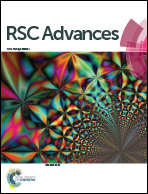Synthesis of novel TiO2/BiOCl@HHSS composites and its photocatalytic activity enhancement under simulated sunlight†
Abstract
A novel TiO2/BiOCl@HHSS photocatalyst (TiO2/BiOCl heterostructured semiconductor supported on hierarchical hollow silica spheres (HHSS)) was synthesized by a facile one-pot method, and further characterized by XRD, HRTEM, SEM, N2 adsorption–desorption analysis and UV-vis diffuse reflectance spectra. Structural characterization indicated that the as-synthesized TiO2/BiOCl@HHSS photocatalyst possessed a special small-hollow-sphere@big-hollow-sphere structure with a diameter of 90–150 nm and a high specific surface area of 414.3 m2 g−1. The TiO2/BiOCl nanoparticles with smaller crystallite size were well dispersed on the HHSS, due to its unique hierarchical sphere structure which composed of much smaller hollow spheres (∼20 nm) covered by external wall. The photocatalytic activity of the photocatalyst was investigated by the degradation of reactive brilliant red (RBR) under simulated sunlight. The TiO2/BiOCl@HHSS composite shows the highest photocatalytic activity among TiO2/BiOCl, TiO2@HHSS and BiOCl@HHSS catalysts, due to its special hollow structure, high surface area and heterostructure. A possible mechanism is proposed to explain the degradation of organic dye molecules over the BiOCl/TiO2@HHSS nanocomposite photocatalyst. The proposed grafting strategy on porous support for the formation of this hybrid photocatalyst can also be applied to other semiconductor candidates resulting in improved photocatalytic performance.


 Please wait while we load your content...
Please wait while we load your content...